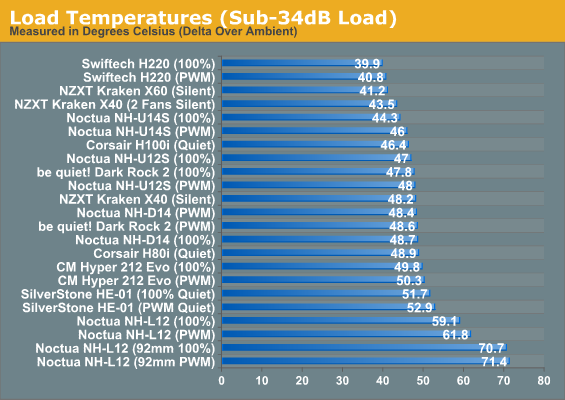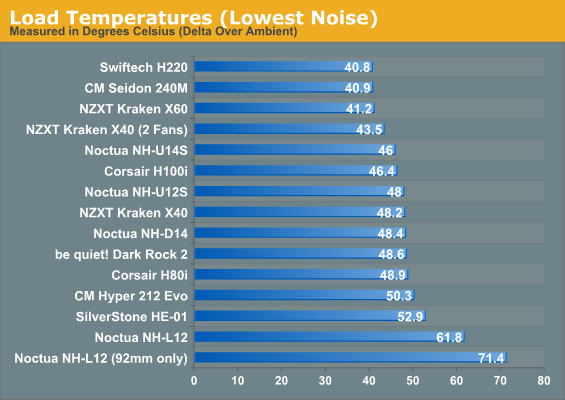Cooler Master Seidon 240M and 12 More Coolers: The Retest and Mega-Roundup
by Dustin Sklavos on April 26, 2013 6:01 AM ESTSilent Running Performance
There was a tremendous amount of data on the previous page; we need to make it easier and condense it into more readily useful information. So we'll start by culling all of the test results where the coolers had to run at higher than 34dB, leaving us with a healthy cross-section of quieter cooling solutions.

This is where Swiftech makes their move. The H220 offers essentially the best low noise performance out of all of the coolers we've tested. Unfortunately, load noise takes the Cooler Master Seidon 240M out of the equation at any level; even with PWM enabled, the 240M went up to 38dB.
You'll also notice that while the top four positions are held by closed loop coolers, air cooling essentially makes its comeback here as a quieter solution overall. The air coolers we've tested are all, outside of SilverStone's HE-01, designed to be silent, so this isn't a surprise. The surprise is more that closed loop coolers running at quiet settings are having a much harder time competing.

Culling all of our data down to the lowest noise settings is even more interesting. Swiftech's H220 continues to do well, but the Seidon 240M sort of cheats: this may be its quietest, but it's still running at 38dB, 5dB higher than the more expensive H220. The NZXT Kraken X40 turns out to do much better in a push-pull configuration, though, and its noise level is just 31.2dB, 2dB quieter than the H220 in exchange for running about 2-3C warmer. The second fan turns the Kraken X40 into a dark horse contender and brings it into the overall conversation; adding the second fan doesn't actually increase load noise at the Kraken's silent setting, but it does bring thermals down by a healthy 5C.










62 Comments
View All Comments
disappointed1 - Sunday, April 28, 2013 - link
With all due respect, this testing methodology is now completely flawed:"For air coolers, I added a Noctua 140mm rear exhaust fan and used the ultra low noise adaptor to ensure it didn't affect acoustics in any meaningful way. This is in line with the usage cases air coolers are designed for, and should be representative of the kind of airflow most users will have from their exhaust fan."
You FUNDAMENTALLY can't compare coolers on the same charts with different testing conditions. The closed-loop coolers are just as much designed, and will be operated, with proper/equivalent case ventilation. Just test them under identical conditions and let the liquid coolers pay any penalty with higher idle noise readings.
epoon2 - Monday, April 29, 2013 - link
I tried the article again, couldn't find where Dustin mentioned his testing method for Water. On the page where he shows the Seidon, it's clearly installed inside the case. I do not believe there is a strong bias towards either air or water coolers in this test.disappointed1 - Tuesday, April 30, 2013 - link
"...I'm now using that exhaust fan for testing air coolers. Closed loop coolers continue to do without."He added an extra case fan for the air coolers, which was not present for the liquid coolers. This will have the effect of biasing the results and renders them void. This is readily apparent by the author's own admission that "the differences in performance were pronounced" and "now liquid coolers aren't the juggernauts they used to be" and cannot be compared with previous results.
Alvar - Monday, April 29, 2013 - link
Today we have something a little special on the table. If you have previously been reading our CPU Cooler reviews you probably saw our recent review for Silverstone. We reviewed the Silverstone Heligon Series – HEO1 CPU Cooler....more details:- http://tinyurl.com/c5czh4b
bobbozzo - Tuesday, April 30, 2013 - link
Spam link above goes to a site for a women's magazine, nothing about coolers.TheStranger81 - Tuesday, April 30, 2013 - link
It would be a review if it actually had any charts....WTF is going on ? Where are the charts ?Wwhat - Saturday, May 4, 2013 - link
Look at how this site does such things:http://www.computerbase.de/artikel/gehaeuse-und-ku...
(language is irrelevant for the subject of graphs)
You can deselect items in the list and when you select a line you can see the position and details as you move the mousepointer over it.
And in their bargraphs it uses mouseover to show the percentage and relative percentage.
Like shown here: http://www.computerbase.de/artikel/gehaeuse-und-ku...
PNG's for data are a bit.. outdated really aren't they? (But perhaps you need to dumb down again for tablets and phones these days?)
Death666Angel - Saturday, May 11, 2013 - link
Can you adjust the air and clc results so that the x-axis is the same unit length? That way it is easier to compare between the two cooler types. :)hooner - Tuesday, July 2, 2013 - link
Great review...thanks!I have a quick question...I am thinking of buying a cooler master N200 and is front or rear radiator cooling best? I am presuming the front fans are intakes, rear and top are out.
My thinking is rear takes heat straight out the back from CPU, where as front means air is drawn in, cooled and then blow back through case. Surely venting the heat straight away is better?
Cheers
SloppyFloppy - Wednesday, September 17, 2014 - link
You keep recommending the really well performing Swiftech H220, but after some research they appear to have server quality control issues with their pumps failing and/or making lots of noise as well as some of their fans being noisy.Now I don't know what cooler to buy that performs well without sounding like a lawn blower.